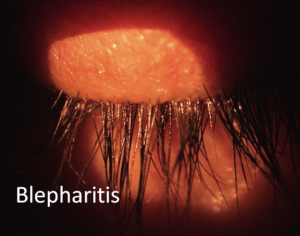
Blepharitis
What is Blepharitis?
Blepharitis is a common and persistent inflammation of the eyelids. Symptoms include irritation, itching, and occasionally red eyes. This condition is caused by debris which accumulates around the eyelashes. You may have heard it referred to as dandruff of the eyelashes. The debris is simply a collection of skin flakes and skin oils. This condition frequently occurs in people who have oily skin, dandruff, or dry eyes. Blepharitis can begin in early childhood, producing granulated eyelids, and continue throughout life as a chronic condition, or it can develop later in life.
Symptoms of Blepharitis:
- Irritation
- Tearing
- Blurry Vision
- Bloodshot Eyes
- Loss of Lashes
- Stinging when applying drops
- Discomfort and Swelling
- Styes or Chalazions (Blocked Oil Gland)
- Itching
- Redness
- Burning
How dangerous is Blepharitis?
Bacteria reside on the surface of everyone’s skin, but in certain individuals they thrive in the skin at the base of the eyelashes. The resulting irritation, sometimes associated with over activity of the nearby oil glands, causes dandruff-like scales and particles to form along the lashes and eyelid margins.
Sometimes the scaling or bacteria produce only minor irritation and itching, but in some they may cause redness, stinging or burning. Some people may develop a sensitivity to the scales or to the bacteria which surround them. Severe cases can lead to bloodshot eyes, loss of lashes, and discomfort and swelling of the eye.
If left untreated, this condition can lead to more serious complications, such as a stye or chalazion. Infections can develop when the bacteria that normally live on the skin of the eyelids begin to multiply very rapidly because the eyelid granulations actually improve their living conditions. It can also lead to inflammation of the eye tissues, particularly the cornea (the clear front window of the eye).
How is Blepharitis Treated?
Blepharitis is a condition that may not be cured, but can be controlled with a few simple daily measures:
At least twice a day, wet a washcloth with comfortably warm water, wring it out, and place over the closed eyelids for 2-3 minutes. Re-wet it as it cools. This will soften and loosen scales and debris. More importantly, it helps liquefy the oily secretions from the eyelids’ oil glands that help prevent the development of a chalazion, an inflamed lump in an eyelid oil gland.
With the washcloth wrapped around your finger or using a cotton swab, gently scrub the base of the lashes for about 30 seconds per lid.
In more severe cases, an antibiotic ointment may be prescribed to alleviate the symptoms.

